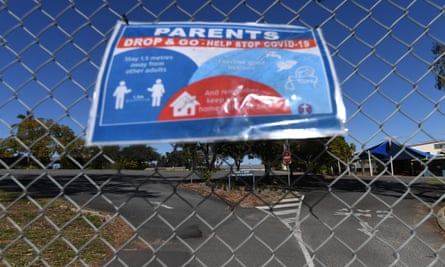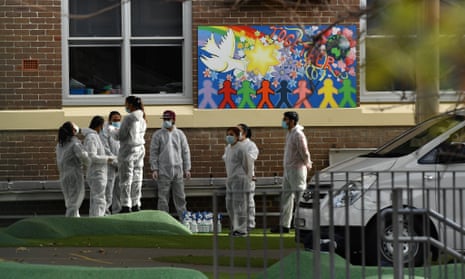The extent to which children are infected with and transmit the highly contagious Delta variant of Covid-19 has been a major source of concern.
Modelling released in Australia on Wednesday will help settle some burning questions around how the virus affects children and how quickly it spreads in educational facilities.
Data published by the National Centre for Immunisation Research and Surveillance (NCIRS) looks at transmission of Covid-19 in schools and households from 16 June to 31 July in New South Wales, the Australian state experiencing the most severe Delta outbreak.
It specifically examined data from the 51 educational settings where infections of children and staff occurred.
What were the key findings?
Most children diagnosed with Delta experienced mild or no symptoms, with only 2% requiring hospitalisation, the NCIRS report said.
This is despite the high transmissibility of the Delta variant, resulting in a fivefold increase in its spread in schools, early childhood education and care services (ECECs), and households compared with the original strain in 2020.
NCIRS director Prof Kristine Macartney said the findings are consistent with recent studies overseas showing that the Delta variant is more transmissible and leads to a greater number of cases among children and young people. But those children do not often become severely ill. Most children in the study had no or only mild symptoms.
“The higher transmission in schools and ECECs, and risk across the wider community, has made stay-at-home learning necessary for most children during the current epidemic period, while we work to achieve higher levels of vaccination rates among school and early childhood staff, and the adult population more generally,” Macartney said.
The chair of the Australian and New Zealand Paediatric Infectious Diseases group, Prof Asha Bowen, said it was important to note that not all of the children admitted to hospital with Covid were severely unwell.
“Many of these [hospital admissions] were for social reasons – particularly ill parents not being able to care for children – so hospitalisation statistics do not provide a good marker of severity,” she said.
“Although severe illness from Covid-19 is rare in children, children are affected by illness in their family members, and by social restrictions causing impacts on education and mental health.”

What else did the study find?
This study monitored all cases where a staff or student with Covid-19 attended a school or ECEC service while infectious. Researchers tracked all secondary contacts, calculating virus transmission rates in the households of those children and staff. Of the 51 educational settings affected, 19 were schools and 32 were ECEC services.
There were 59 people – 34 students and 25 staff members – with Covid who attended an educational setting while infectious. Among these 59 primary cases, 2,347 close contacts including 1,830 students and 517 staff members from educational settings were identified. A Covid test was taken by 96% (2,253) of these close contacts.
The researchers found the overall transmission rate from primary cases to close contacts was 4.7%, or 106 secondary cases. These secondary cases included 69 students and 37 staff members. Virus transmission occurred in 19 (38%) of the 51 educational settings affected.
Where did the highest/lowest transmission occur and why?
Almost 17% of transmission occurred in ECECs between staff members. Just 8% of transmission in ECECs occurred from a staff member to children.
“The spread between children themselves was very low,” Macartney said.
The majority of ECEC staff members are young (64% are under 40 years old) and were not yet eligible for vaccination at the time of the study, the report said. ECECs were also open at the time with no restrictions, had high attendance rates and were in local government areas that went on to have the highest community incidence rates of Covid-19 in Sydney. The start of the greater Sydney lockdown coincided with the commencement of the two-week school winter holiday period. During that time, ECEC, vacation care and out-of-school-care services were kept open.
“Transmission was low in schools as a likely result of the school holiday period and subsequent limited attendance in term 3, when the majority of greater Sydney school students engaged in remote learning,” the report found.
Household transmission was a much more pressing issue. Staff and children who caught Covid-19 at a school or ECEC service often passed it on to their household members, the researchers found. There were 181 household cases following exposure to the 106 secondary cases from the school or ECEC service. The overall transmission rate among household contacts was 70.7%.
In 55 households (57% of them), all household members ended up with Covid.
The rate of transmission in both schools and ECECs, as well as in households, was around five times higher than seen in educational settings and households in 2020.
In follow-up data taken from 31 July to 19 August 2021, cases occurred in 91 educational settings (10 high schools, 33 primary schools, 45 ECECs and 3 K-12 schools), taking the total number of educational settings involved in the NSW outbreak to 142. Detailed information on transmission from these additional schools and ECECs will be included in a future NCIRS report.

What should parents take from the report?
Leader of the study, Dr Archana Koirala, a paediatric infectious disease specialist at the University of Sydney, said full participation in education is essential for children to learn and develop socially, but also for family and societal functioning.
“These results should give confidence to families, schools and the community that we have robust evidence on how the Delta variant behaves in children and educational settings,” she said.
“This evidence is being used to design strategies for returning to face-to-face learning safely as we learn to live with Covid-19.”
The report said although many children are being infected with Covid-19, they are rarely hospitalised.
“There are however long-term consequences of lack of access to education; for example, the loss of one-third of a school year of learning has been estimated to reduce future earned income of the affected students by about 3%,” the report said.
“Higher population-level rates of Covid-19 vaccination, including vaccination of school/ECEC staff, are critical to reduce the risk of transmission in the community and in educational settings. In addition, vaccination of adolescents … in higher risk LGAs, which is currently occurring as part of the outbreak response, is an important step towards returning students into the classroom.”
